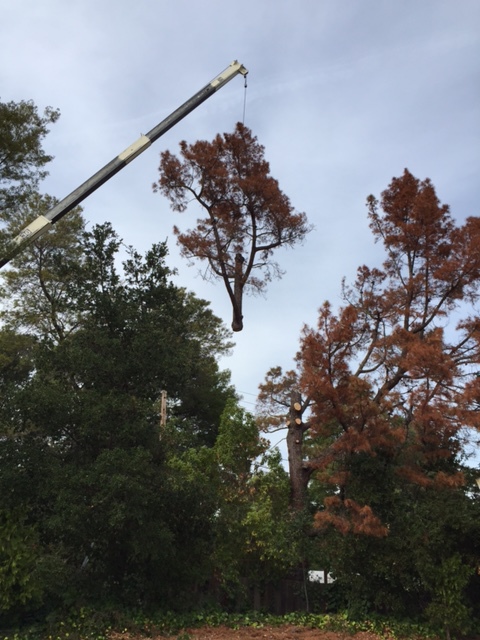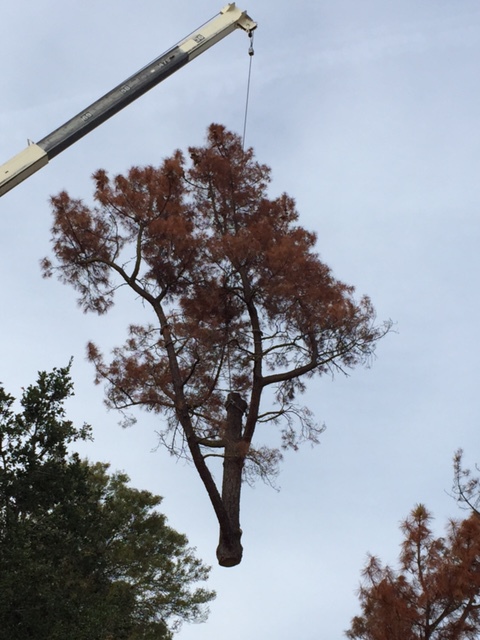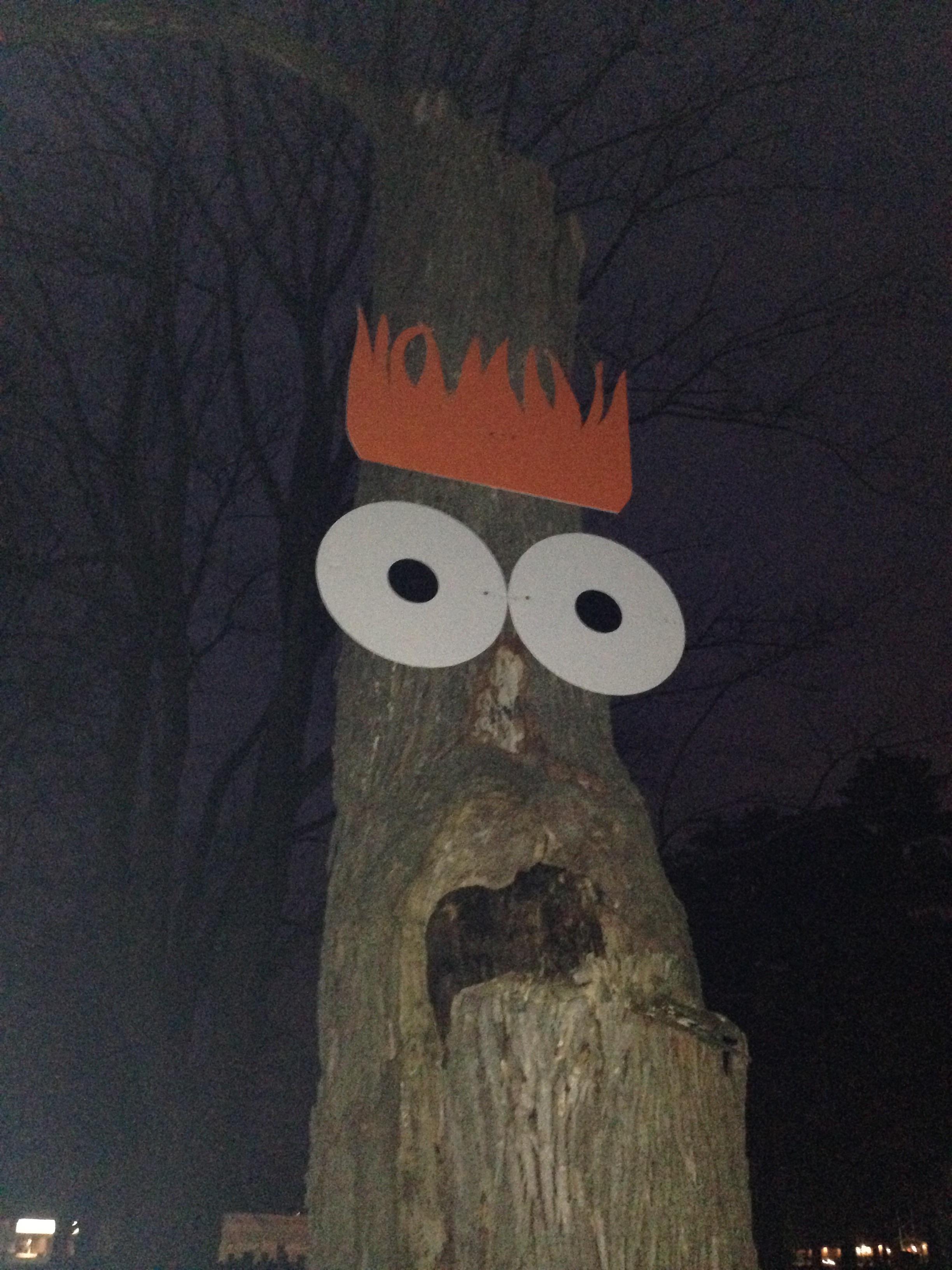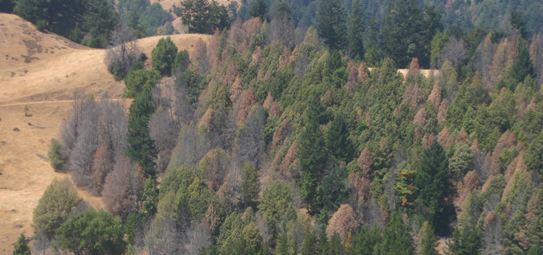We just completed a multiple tree removal job at Sequoia Hospital in Redwood City. We were able to bring the crane into the hospital parking lot and removed 4 Acacias, 1 Redwood and 2 Pines. Normally, a job like this without a crane would take multiple days and would not be as effective and more dangerous. We are lucky to have a large capacity crane that is able to handle these types of removals. Our skilled workers go to work and were able to finish in 1 day. Here is a great picture of the crane at work.
November 14, 2014 Newsletter
Fertilize your trees!
Some of you have called and asked what you can do to keep your trees healthy during this drought. We have a solution for you! FERTILIZATION! We offer a treatment that gets right to the roots of the tree and provides nutrients and water that is very necessary to keep your trees heatlhy throughout the cold winter. While we don’t see the extreme winters that a majority of the United States sees, are trees still need care during the cold winter months. Winter fertilization helps the roots of the tree grow, even though there is no leaf growth.
It is also recommended to lay down a layer of mulch around the base of the tree. This helps with temperature, keeping the roots from the colder temperatures, and mulch also helps keep the moisture in the roots. If you are needing mulch for your trees and yard, make sure to call our office. We will deliver free mulch to your door that can be used for many purposes. We also sell high quality redwood chips that are perfect for mulching around trees and also as a decorative ground cover.
If your trees are not looking their best, give our office a call and we will send an arborist out to take a look at your trees! Call today at 650-200-2495.
October 31, 2014 Newsletter
HAPPY HALLOWEEN!
Someone was crazy enough to decorate their tree for Halloween..
One of the many services we offer here at Econo Tree Service is plant health care. This covers everything from fertilizing your trees, to treating your oak trees for Sudden Oak Death and spraying other trees for aphids.
Much like the human body, trees have very complex system that can be affected by several outside factors. For example, pests. There are a large variety of bugs that can have an affect on a tree. Throughout the year we get calls regarding aphid infestations. Aphids often leave a mildew on the leaves of trees and can turn leaves black. It also interferes with photosynthesis.
Another area of plant health care we specialize in is fertilization. Now more than ever fertilization is important as trees may not be getting the nutrients it needs in order to sustain the winter. We use a deep root treatment where we have a special applicator that gets deep into the ground and injects a fertilization solution that gets sucked into the roots of the tree and in the rest of the tree. You can fertilize any tree! If you see a tree that may look like it needs a bit of help, fertilization may be just the solution.
One other are of plant health care that we provide is Sudden Oak Death treatment. As has been discussed before on the blog, our area has been affected by Sudden Oak Death. It started up in the hills and has reached its way down to the urban area. If you have Oak trees on your property, they are at risk for Sudden Oak Death. We use a preventative treatment that aids in defending against Sudden Oak Death. There is no cure for SOD, so it’s important to take the steps before you see any problems.
For more information about plant health care, check out this handout with other important information from our friends over at treesaregood.com!
If you have any other questions or would like an arborist to come and take a look at your trees, give our office a call today! 650-367-4900 – we can’t wait to hear from you!
October 17, 2014 Newsletter
Let’s talk… Coast Live Oaks!
The majority of Oak trees we see here in our neck of the woods is the Coast Live Oak, or the Quercus agrifolia. This tree is native to our coastal region in California. The Coast Live Oak is an evergreen tree and can grow to be up to 80 feet tall, but generally grows to about between 20 feet and 40 feet high. The Coast Live Oak has a lovely canopy that provides lovely shade for those who sit underneath. They have a very long life if they are well cared for. The name Quercus agrifolia literally means “field leaved Oak”.
October 10, 2014 Newsletter
The Giants made it to the NLCS!
GO GIANTS GO!
We have spoken to a few of you regarding Sudden Oak Death recently and some have asked about where Sudden Oak Death can be found. This site has a great interactive map about where Sudden Oak Death is at it’s most severe. While many of the sightings are in the mountains, there are quite a few that are in the urban area. This means that any Oak tree in our area is susceptible to Sudden Oak Death. This is very important to remember.
If you have not treated your Oak trees for SOD previously, we highly recommend you treat them today. It is a simple method where we apply a chemical treatment to the trunk of the Oak tree. This is a protective treatment only. There is no cure for SOD. It has been estimated that over 3 million trees have died as a result of SOD.
Now is the best time to treat for Sudden Oak Death as the Oaks wood is more absorbent and able to take on the treatment necessary for protecting the Oaks from SOD. The UC Berekeley Forest Pathology and Mycology Lab has created an app specifically designed to show the rate of risk your trees may be of SOD. Any infections within 1000 meters of your trees have the capacity to infect your Oak trees. You can check out the app here.
October 3, 2014 Newsletter
First of of all ..
GO SAN FRANCISCO GIANTS!!!
The Bay Area is poised to have a hot weekend! This also means fire danger is very high for our area, and we are in the middle of a very severe drought. If you are in our hills and up in the mountains your home may be surrounded by trees and brush. Did you know that there are guidelines to how much space there should be between your property and your trees and shrubs? This is known as defensible space. This is a great article about defensible space and what you should be doing to make sure your are prepared and your home and family is fire safe.
Do you have trees with lots of dead wood and shrubs that look dry that are within 30 feet of your home? This is called the Home Defense Zone. In this area it is important that all dead vegetation is removed. That any gutters, your roof and your yard is clear of dead and dry leaves and Pine needles. Trees are pruned regularly to clear any structures. Do you  hvae a deck? Make sure that any plants or shrubs are cleared away. Also, make sure that there is a separation between trees and shrubs within this zone. This is very important as it will stop fire from a continuous burn and gives it a chance to break up and slow it down!
hvae a deck? Make sure that any plants or shrubs are cleared away. Also, make sure that there is a separation between trees and shrubs within this zone. This is very important as it will stop fire from a continuous burn and gives it a chance to break up and slow it down!
Also, if you have Eucalyptus trees on or near your property, they are known fire hazards. Make sure they are kept clear of dead and dangerous branches.
We are very lucky to be living in such a beautiful area, but it is also prime real estate for a wildfire. These are just a few things you can do to make sure your home is playing a good defense in the unfortunate instance of being within a fire zone. Your property is one of your most prized possessions, so be sure you are in the clear when it comes to fire safety!
Give our office a call if you have any questions or need us to come and take a look at any dead or dangerous hazards that may be lurking. It’s always better to be safe than sorry!
September 26, 2014 Newsletter
You will be receiving phone calls from us in the coming week about Sudden Oak Death or SOD. While some of our clients do already treat their Oaks for SOD on a yearly schedule with us, many of you do not. So, here’s some valuable information about Sudden Oak Death that you will want to consider when we give you a call:
– There is no cure for Sudden Oak Death. But early detection is essential for control over the disease. We live in an infected area, so it has already caused major damage on trees in the forests here.
– When we spray your Oaks to protect against SOD, it is for protection against SOD. Much like one takes vitamins to build up our body against diseases, our SOD treatment helps prevent SOD from infecting your Oak trees. We use a foliar spray that is organic and non-toxic.
– This is a great article and website about diagnosing SOD on your trees. It shows pictures and gives suggestions on what to look for. One IMPORTANT thing to note is that if you have California Bay Laurels on your property that are near your Oaks, they are known carriers of SOD. If there are dead tips on the Bay Laurels, this could be a sign that you may have SOD.
– If you have never had your Oaks looked at for Sudden Oak Death, please give our office a call and we will have a certified arborist come and take a look.
September 19, 2014 Newsletter
September 22 marks the first day of fall for us. This means we will start seeing the leaves on the tree change color. While we don’t get quite the dazzling color show here on the west coast as the folks on the east coast do, we do have some trees here that will show off it’s fall colors. The following trees are deciduous trees that loose their leaves in Fall.. I know some of our customers have these trees in their landscape
- Maple
- Some Oaks (Pin Oaks, Red Oaks, Scarlet Oaks, Black Oaks, White Oaks)
- Dogwood
- Persimmon
- Chestnut
- Beech
- Birch
- Sycamore
The leaves of these trees change from their normal green color to the glorious yellow, orange and red colors we are used to seeing in the fall.
The green color that we see in leaves during the spring and summer comes from a chemical called chlorophyll. It aids in the process of photosynthesis which i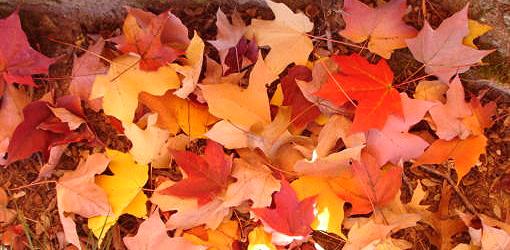 s how trees produce food for itself, and which also gives us oxygen. The chlorophyll is responsible for capturing the sun’s rays and using the energy to manufacture the tree’s food. During the spring and summer, chlorophyll is abundant and the leaves stay green. As daylight gets less and less and the temperature grows cooler, the production of the chlorophyll slows down, thus allowing the other pigments of the leaf to show. This is when the leaves turn to their vibrant fall colors.
s how trees produce food for itself, and which also gives us oxygen. The chlorophyll is responsible for capturing the sun’s rays and using the energy to manufacture the tree’s food. During the spring and summer, chlorophyll is abundant and the leaves stay green. As daylight gets less and less and the temperature grows cooler, the production of the chlorophyll slows down, thus allowing the other pigments of the leaf to show. This is when the leaves turn to their vibrant fall colors.
There are other pigments that contribute to the color of the leaves, carotenoids and anthocyanins. These give us the brilliant yellows, oranges, reds and sometimes purple colors in the leaves. The brown color we often see in leaves is the result of waste that is left over.
It will be an interesting fall this year as we are in the middle of a severe drought, and some of the trees are already loosing their color due to the lack of water. It’s important to know what the difference between the leaves changing color for fall and if they are ill. If you are unsure, it’s important to contact an arborist who can come and give your trees a health check.
Make sure to call the office for any questions you may have about your trees. We are more than happy to come and give your trees a health check up!
September 5, 2014 Newsletter
When it’s time to let go….
While we always do our best to save a tree, it may be that the tree needs to be removed. If you took a look at your trees over the Labor Day holiday weekend and noticed some things may not look as they should, it’s likely the tree may be damaged or dying. Once this diagnosis is made there are a few important factors to keep in mind.
One of the very first things that we check before we even start a removal job is to check if a removal permit is required for the removal. If we are removing a large tree, the chances of the tree requiring a permit is quite high. And the great news is that we do all of our own permit processing in house for you! Most permits require an arborist letter, some need sketches and some may need pictures. As part of our full tree service mantra, we are available to take care of these things for you. We know that dealing with all that paperwork can be quite a headache, that is why we will take care of it for you. If you aren’t sure if your city or county requires a permit for your tree, give our knowledgeable and friendly office a call and we will be more than happy to answer any question you might have.
Safe removal is key. We have several methods for removing trees. If the tree is easily accessible, a crane removal may be necessary. Thankfully, we here at Econo Tree Service have just the right equipment for the job. A few years ago, we purchased a heavy duty  crane because we had been getting requests for large tree removals. We have used our crane on several removals over the past few years and find it to be the most efficient and safest way to remove large trees.
crane because we had been getting requests for large tree removals. We have used our crane on several removals over the past few years and find it to be the most efficient and safest way to remove large trees.
If crane removal is not possible, we may also use a bucket truck to reach the highest parts of trees to cut and lower chunks of wood safely down to the grade. We also have certified tree climbers who are skilled in safely cutting and lowering wood to the ground as we remove your tree
We know that for some of you, your trees are a very important and well loved part of your home. I spoke to a recent client who had originally planted her trees when she moved in several years ago and was now faced with having to have it removed. It can be sometimes be quite heartbreaking to see a beloved part of your home being removed. But, it is always possible we may be able to save the wood for you. We have had clients re use the wood from trees that we have taken down for home projects, like benches and tables. We have also cut up chunks of the tree trunks for stepping stones on a path. There are many creative ways to recycle the wood from the removal of a tree.
We also cut and sell firewood on site at our yard We have a log splitter that cuts the wood into fireplace size pieces that can be used in your fireplace during the cold winter months. We only sell well aged firewood from Oak trees that we have removed. This ensures that you are receiving the highest quality firewood.
From removing trees to providing highest quality firewood, trees are our specialty. Give our office a call today to find out how we can get to work for you!
August 29, 2014 Newsletter
Tree Risk Checklist
With today being the closing out of the summer season, many of us are going to be spending plenty of time outdoors. As you enjoy the beautiful summer weather, we ask you to take a few minutes to inspect the trees around your landscape. Has in been a while since you’ve hard your trees pruned and cared for? Here is a list of things you will want to look at to determine if your trees are in need of tree care:
while since you’ve hard your trees pruned and cared for? Here is a list of things you will want to look at to determine if your trees are in need of tree care:
- Dead branches
- Severed branches hanging in the tree
- Any cavities or rotting wood along the trunk
- Is the trunk leaning?
- Any fungus visible at the base of the tree.
If you see any of the above issues with your trees, you need to have your trees inspected by a certified arborist. Any of these signs could point to any number of issues. It could be that your tree is in need of a good pruning. This would remove any deadwood, restore balance and shape, open the canopy so that all of the parts of the tree received much needed light, and then restoring it to its natural beauty.
It’s the homeowners responsibility to be aware of the health and hazards of the trees on his or her property. Trees can grow to such massive sizes that a fallen branch could be especially dangerous to properties and in very dangerous to properties or anyone that may happen to be near it!
Another important thing to look at when checking your trees are hazards to any ut ility lines. If you notice any large branches or any other tree type hazards near your utility lines, give PG&E a call. Check this article for more information. If trees fall into utility lines, there could be serious consequences.
ility lines. If you notice any large branches or any other tree type hazards near your utility lines, give PG&E a call. Check this article for more information. If trees fall into utility lines, there could be serious consequences.
We will be heading into the fall season in just a few short week and all of the beauty and majesty of the colors the trees display. Let’s make sure your trees are ready for the fall and have us come and inspect your trees today!





